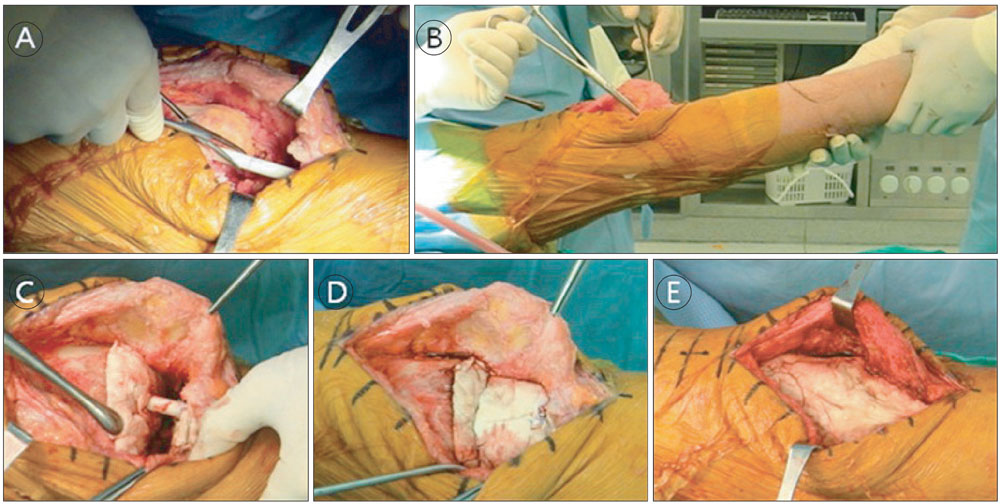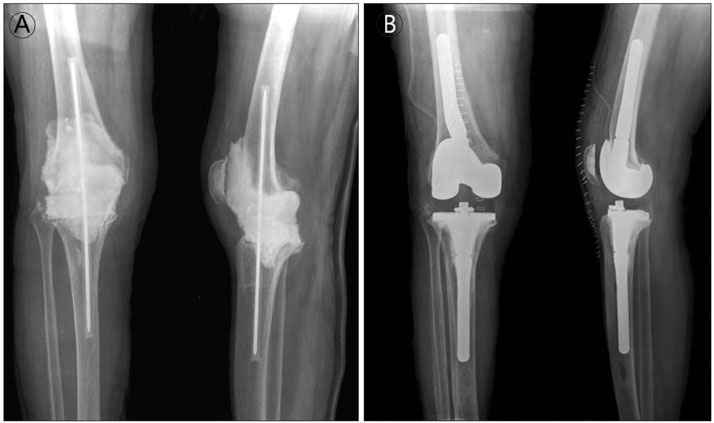Clin Orthop Surg.
2011 Sep;3(3):245-248. 10.4055/cios.2011.3.3.245.
The Modified Static Spacers Using Antibiotic-Impregnated Cement Rod in Two-Stage Revision for Infected Total Knee Arthroplasty
- Affiliations
-
- 1Department of Orthopedic Surgery, National Health Insurance Corporation Ilsan Hospital, Goyang, Korea. changjihoon@hotmail.com
- 2Department of Orthopedic Surgery, Yonsei University College of Medicine, Seoul, Korea.
- KMID: 1743916
- DOI: http://doi.org/10.4055/cios.2011.3.3.245
Abstract
- The two-stage exchange arthroplasty (one- or two-stage) is believed to be the gold standard for the management of infections following total knee arthroplasty. We herein report a novel two-stage exchange arthroplasty technique using an antibiotic-impregnated cement intramedullary nail, which can be easily prepared during surgery using a straight thoracic tube and a Steinmann pin, and may provide additional stability to the knee to maintain normal mechanical axis. In addition, there is less pain between the period of prosthesis removal and subsequent reimplantation. Less soft tissue contracture, less scar adhesion, easy removal of the cement intramedullary nail, and successful infection control are the advantages of this technique.
Keyword
MeSH Terms
-
Aged
Anti-Bacterial Agents/*administration & dosage
*Arthroplasty, Replacement, Knee
*Bone Cements
*Bone Nails
*Device Removal
Female
Gentamicins/administration & dosage
Humans
Knee Prosthesis/*adverse effects
Orthopedic Procedures/methods
Prosthesis-Related Infections/*therapy
Reoperation
Vancomycin/administration & dosage
Figure
Reference
-
1. Blom AW, Brown J, Taylor AH, Pattison G, Whitehouse S, Bannister GC. Infection after total knee arthroplasty. J Bone Joint Surg Br. 2004. 86(5):688–691.
Article2. Hanssen AD, Rand JA. Evaluation and treatment of infection at the site of a total hip or knee arthroplasty. Instr Course Lect. 1999. 48:111–122.3. Goldman RT, Scuderi GR, Insall JN. 2-stage reimplantation for infected total knee replacement. Clin Orthop Relat Res. 1996. (331):118–124.
Article4. Windsor RE, Insall JN, Urs WK, Miller DV, Brause BD. Two-stage reimplantation for the salvage of total knee arthroplasty complicated by infection: further follow-up and refinement of indications. J Bone Joint Surg Am. 1990. 72(2):272–278.
Article5. Emerson RH Jr, Muncie M, Tarbox TR, Higgins LL. Comparison of a static with a mobile spacer in total knee infection. Clin Orthop Relat Res. 2002. (404):132–138.
Article6. Hofmann AA, Kane KR, Tkach TK, Plaster RL, Camargo MP. Treatment of infected total knee arthroplasty using an articulating spacer. Clin Orthop Relat Res. 1995. (321):45–54.
Article7. Leone JM, Hanssen AD. Management of infection at the site of a total knee arthroplasty. Instr Course Lect. 2006. 55:449–461.
Article8. Fehring TK, Odum S, Calton TF, Mason JB. Articulating versus static spacers in revision total knee arthroplasty for sepsis: the Ranawat Award. Clin Orthop Relat Res. 2000. (380):9–16.9. Goldstein WM, Kopplin M, Wall R, Berland K. Temporary articulating methylmethacrylate antibiotic spacer (TAMMAS): a new method of intraoperative manufacturing of a custom articulating spacer. J Bone Joint Surg Am. 2001. 83-A:Suppl 2 Pt 2. 92–97.10. Haddad FS, Masri BA, Campbell D, McGraw RW, Beauchamp CP, Duncan CP. The PROSTALAC functional spacer in two-stage revision for infected knee replacements: prosthesis of antibiotic-loaded acrylic cement. J Bone Joint Surg Br. 2000. 82(6):807–812.
- Full Text Links
- Actions
-
Cited
- CITED
-
- Close
- Share
- Similar articles
-
- Two-Stage Reimplantation in Infected Total Knee Arthroplasty
- Comparison of Articular Spacer Versus Static Spacer in the Treatment of Infected Total Knee Arthroplasty
- Staged Reimplantation Using Cement Spacer Containing Antibiotics in Infected Total Knee Arthroplasty
- Revision of Infected Total Knee Arthroplasty: Two-Stage Reimplantation Using an Antibiotic-Impregnated Static Spacer
- Two - Stage Revision of Infected Total Knee Arthroplasty using Antibiotics: Impregnated Cement Spacer




